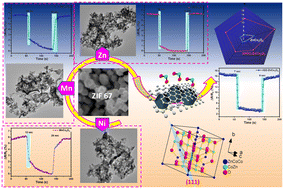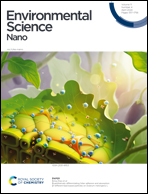Cation substitution effects (Mn, Ni, and Zn) on ZIF-67 derived spinel modified with 3DGO for the detection of NO2 gas with high sensitivity and selectivity†
Abstract
The need to improve the sensitivity, selectivity and stability of NO2-based gas sensors that are capable of monitoring toxic gases in the environment has sparked research attention among scientists. In this direction, herein, we propose three different cation-substituted MOF-derived spinels (MCo2O4, M = Zn, Ni, and Mn) using ZIF-67 as a template for potential NO2-based gas sensors. Among the three spinel-based sensors, the ZnCo2O4 spinel showed enhanced sensitivity. Our results showed that the sensing performances of MCo2O4 having a slightly distorted dodecahedron shaped structure varied when different cations (M2+ = Zn, Ni, and Mn) were substituted into the MCo2O4 spinels. In comparison to the other two spinels, such as NiCo2O4 and MnCo2O4, the perfect dodecahedron-shaped ZnCo2O4 nanostructures allowed more open pores for better gas diffusion and provided more active sites for gas adsorption, while maintaining good electrical conductivity. This p-type sensor also exhibited an ultralow detection limit of up to 5 ppm towards NO2 detection with fast response and recovery, as well as adequate selectivity. The pristine ZnCo2O4 showed higher responses (S% = 7.6%) with low response time (10 s) and recovery time (13 s) at higher temperature (150 °C). Later on, to enhance its performance, ZnCo2O4 was supported on 3D-graphene oxide (3DGO) to develop an efficient composite sensor for sensing at room temperature. The composite (3DGO-ZnCo2O4) showed p-type responses and formed a n–p heterojunction at their interface with an enhanced sensing performance of about 17.6% and lowest response–recovery time (7 s and 9 s, respectively) at room temperature. Our study demonstrated the advantages of combining the effects of higher electrical conductivity and larger specific surface of 3DGO with enhanced surface defects in MOF-derived ZnCo2O4 for the adsorption of greater number of NO2 gas molecules.

- This article is part of the themed collection: Nanomaterials in air


 Please wait while we load your content...
Please wait while we load your content...